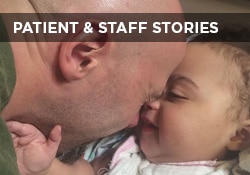This website uses cookies so that we can provide you with the best user experience possible. Cookie information is stored in your browser and performs functions such as recognising you when you return to our website and helping our team to understand which sections of the website you find most interesting and useful.

Susan E. Mazer, Ph.D. Blog
Thoughts and ideas on healthcare
Hi, and welcome to my blog! I'm Susan E. Mazer -- a knowledge expert and thought leader on how the environment of care impacts the patient experience. Topics I write about include safety, satisfaction, hospital noise, nursing, care at the bedside, and much more.
How Are Patient Safety and the Patient Experience Related?
December 2, 2016
 I am confused. How can patients have good experiences if they do not feel safe?
I am confused. How can patients have good experiences if they do not feel safe?
And, how is patient safety evidenced beyond the accidents that do not happen?
Safety precautions are ever present in our daily lives. The wet floor caution sign in a public restroom; flashing lights on the road; the warnings at the end of drug commercials.
More critically for patients in the hospital, however, are the warnings and alerts for medication ordering using electronic medical records (EMRs). Or the protocols for preventing falls that seem inconvenient because the patient seems too healthy to need them.
Focusing on the Obvious for Patient Safety
Accidents happen because we do not think they will happen. They occur when we are so sure of ourselves or have otherwise prioritized our focus that we miss the obvious.
The Joint Commission’s 2016 list of safety goals for hospitals seeking accreditation lists these three “elements of performance” for surgery:
- Make sure that the correct surgery is done on the correct patient and at the correct place on the patient’s body.
- Mark the correct place on the patient’s body where the surgery is to be done.
- Pause before the surgery to make sure that a mistake is not being made.
These seem obvious, right? Yet, too many errors are still made and patients assume that they are safe in the hands of experts. However, these three seemingly simple tasks indicate that mistakes may occur in plain sight.
Creating a Patient Safety Experience
So, how do patients experience safety? How does the patient experience include the palpable feeling of being safe and being kept safe?
Some thoughts for the healthcare staff to create a better patient safety experience:
- Talk about hidden risks, like clutter on the floor and bathroom leaks that make them slippery, or tangled IV poles.
- Involve family members and patients. Ask family members to be your partner in keeping the patient safe; give them your pager number and access to request housekeeping to change linens, remove trays, and empty the trash. Talk to them as you wash your hands and each time you are in the room.
- Talk about the risks of stress and the benefits of calm. Put on The C.A.R.E. Channel or other programming that provides relief from worry. Show them how to adjust the light in their room. Make sure the furniture in the room does not become an obstacle course to the bathroom.
Being open, obvious, and repetitive in demonstrating the relentless and ongoing concern about the welfare of patients and their family while they are in your hospital does help make the case that their safety is being handled.
Patient safety cannot be a covert intention. It cannot be subtle or hidden.
And, it involves even the simplest of tasks, like hand-washing. Use every opportunity to reassure and reinforce how critical every detail is.
Let your patients, their families, your co-workers, and others know that safety is not only a regulation and a risk, it is an ethic of practice.
To almost invoke the well-known quote from Ghandi, “Be the protection that you promise to your patients.”
P.S. If you like this post, please do me a favor and share on LinkedIn, Twitter, Facebook, etc. Also to get automatic notices when a new post is published, subscribe (upper right). No spam – just great content. Thanks!










